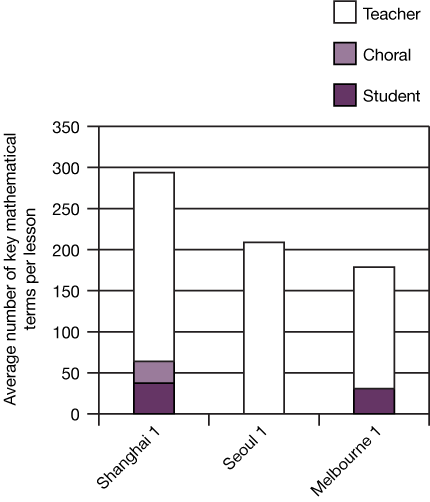
Cultural differences in teaching and learning
Research 7 Aug 2013 6 minute readPeople in different cultures might learn in fundamentally different ways, Hilary Hollingsworth explains.
Cultural differences in teaching and learning
Teaching styles and classroom practices from country to country can be significantly different. These differences include variations in teacher and student classroom talk and physical activity, and student self-regulation. While these differences are sometimes assumed to be related to socio-cultural factors rather than cognition itself, it’s possible that people in different cultures learn in fundamentally different ways.
Classroom talk
The importance of student classroom talk to effective student learning has been a consistent message of research conducted in Australian, European and American classrooms. Despite this emphasis in western educational literature, mathematics classrooms in China and Korea – countries that perform well in international testing – have historically not made use of student-student spoken mathematics as a pedagogical tool. Research led by Professor David Clarke from the University of Melbourne investigated the patterns of student spoken participation in competently taught eighth grade mathematics classrooms in a range of countries.
Korean students have been consistently successful in large-scale international achievement studies, the Trends in International Mathematics and Science Study (TIMSS) and Programme for International Student Assessment (PISA). This success is achieved in classrooms that place almost no emphasis on student spoken participation, which suggests that student classroom talk is not essential to some forms of mathematical learning. On the other hand, if facility with the language of mathematics is a valued outcome, it would seem that proficiency requires the provision of opportunities to rehearse such language use.
Figure 1. Classroom talk using mathematical terms in mathematics classrooms in three cities (each bar represents the average of five lessons)

Neuroscience may be able to help distinguish between types of learning that can be promoted successfully without student classroom talk, and types of learning that are facilitated by student classroom talk.
Carefully crafted lessons
Each instructional act has its learning consequences. The effectiveness of the instruction will depend as much on the combination of the teacher’s actions as on the individual acts.
The TIMSS 1999 Video Study analysed classroom teaching practice in Year 8 mathematics and science classrooms in various countries. The basic sequence in one of the Japanese public release lessons from that study was:
- The teacher introduced the problem.
- The teacher observed and assisted while students worked on the problem.
- The teacher invited selected students to present their solutions.
- The teacher summarised solution methods.
While this sequence might seem unsurprising, a close analysis of the lesson video revealed a carefully crafted sequence of deliberate teaching acts that provided sophisticated scaffolding for problem solving. For example:
- The teacher devoted significant time to ensuring that students understood precisely what the problem was asking.
- The teacher used carefully prepared diagrammatic and textual ‘props’ to demonstrate key aspects of the problem statement.
- As students worked on the problem, the teacher interacted with individuals, providing direction or provoking further thought.
- When selecting students to present their solution methods, the teacher ensured a range of methods was included and that each method was strategically positioned on the board to create a record of method types in order of sophistication.
This example of Japanese pedagogy demonstrates sophisticated teaching practice utilising a number of strategic pedagogical moves.
Each instructional act has its learning consequences. The effectiveness of the instruction will depend as much on the combination of the teacher’s actions as on the individual acts. Neuroscience can help researchers understand the learning consequences of particular teaching acts. However, any recommendations for classroom practice will need to take into account the social organisation of those acts.
Using the tools of neuroscience
Mathematics classrooms are complex places, as a result of the complex social interactions occurring in them. The role of students’ classroom talk; the sequence of instructional acts that make up a lesson; the nature of student thinking when involved in problem solving; and the function of student explanation and worked examples in triggering student learning responses all contribute to this complexity.
Even so, it may be possible to identify key characteristics of classroom interactions with sufficient precision for a clinical experiment designed to identify students’ learning in terms of either brain activation or neural networks.
However, it is possible that a teacher’s effectiveness as a whole does not derive from the individual acts, but from the cumulative interaction of their sequenced deployment.
A challenge for any research project seeking to connect socio-cultural research with neuroscience is to interweave the complementary account provided by each approach. Rather than offering different explanations of the same phenomenon, the two disciplines are likely to offer explanations of related phenomena that are different in scale and complexity. The findings of one discipline could be used to explicate, elaborate, and explain learning as it is conceived in the other discipline.
In studying teaching and learning in different classrooms around the world, the apparent contradictions that appear to pose the greatest challenge for useful interpretation may also provide the greatest insight. A research partnership between socio-cultural and neurological approaches should generate similar challenges, which on close examination offer opportunities for significant insight into learning as a social and an individual phenomenon.
Further information:
This article is based on the conference paper, ‘Challenges and Opportunities for Neuroscience: How to explain the connection between socio-cultural practices and cognition?’ delivered by ACER Senior Research Fellow Dr Hilary Hollingsworth with University of Melbourne Professor David Clarke at the 2013 ACER Research Conference on the theme ‘How the Brain Learns: What lessons are there for teaching?’ on 6 August.
The conference proceedings, including full conference papers, are available from the ACER research repository.
